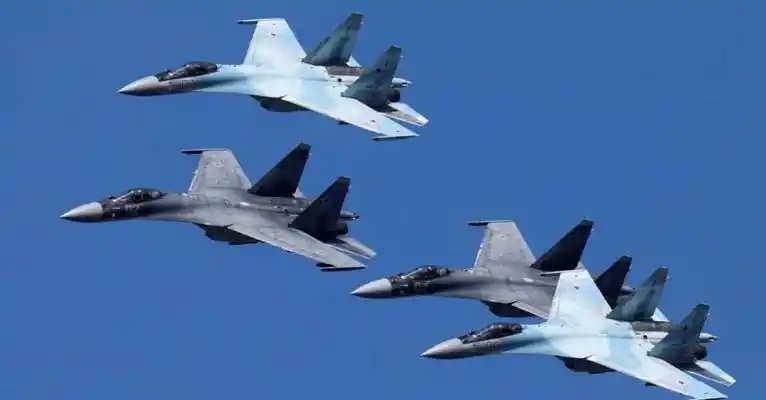Iran’s recent acquisition of Russia’s Sukhoi Su-35 fighter jets marks a significant step in bolstering its aerial capabilities, with potential regional and global consequences. The Sukhoi Su-35, one of the most advanced fighter jets in Russia’s arsenal, offers Iran a technological leap forward in its air defense capabilities. This article explores the details of the Su-35, Iran’s motivation for acquiring these jets, and the broader implications for regional security and geopolitics.
Overview of the Sukhoi Su-35
The Sukhoi Su-35 is a multi-role fighter jet developed by Russia, designed to perform in both air-to-air and air-to-ground combat scenarios. Originally developed in the 1980s as a modernized variant of the Su-27, it has evolved over the years into a highly capable, fourth-generation fighter that is sometimes considered 4.5-generation due to its advanced avionics, radar, and aerodynamic performance. Key features that set it apart include advanced thrust vectoring engines and an impressive range of weaponry.
The Su-35’s advanced technology allows it to compete against fifth-generation fighters, such as the American F-22 Raptor and F-35 Lightning II, making it a valuable asset for countries seeking high-end air superiority capabilities without acquiring stealth technology.
Why Iran is Acquiring Su-35s
For years, Iran has relied on an aging fleet of fighter jets, primarily composed of American-made F-4s, F-5s, and F-14s, which were acquired before the Iranian Revolution of 1979. Due to sanctions and limited access to foreign military equipment, Iran has faced difficulties modernizing its air force. The acquisition of Su-35 fighter jets provides Iran with a long-overdue upgrade, enabling it to defend its airspace more effectively and assert a stronger presence in the region.
Additionally, Iran’s defense strategy has historically focused on asymmetric warfare tactics, such as missile technology and drone capabilities. The Su-35 acquisition signals a shift, as it enhances Iran’s conventional military capabilities and could serve as a deterrent to regional adversaries.
Key Capabilities of the Su-35
The Su-35 comes equipped with various capabilities that make it a formidable addition to Iran’s air force. Here’s a closer look at some of its most critical features:
Engine and Maneuverability
The Su-35 is powered by two Saturn AL-41F1S engines, featuring thrust vectoring technology. This allows it to maneuver at extreme angles, giving it superior agility in dogfights.
With a maximum speed of Mach 2.25 and a combat range of up to 1,600 kilometers (without refueling), the Su-35 can conduct long-range missions across Iranian and neighboring airspace.
Avionics and Radar Systems
The jet is equipped with the Irbis-E passive electronically scanned array (PESA) radar, capable of tracking multiple targets over 400 kilometers away.
The radar can detect stealth aircraft and low-flying drones, providing Iran with enhanced situational awareness and targeting precision.
Armament and Payload Capacity
The Su-35 has 12 hardpoints, allowing it to carry a variety of air-to-air and air-to-ground missiles, bombs, and other payloads.
It can be armed with the R-77 medium-range missile, R-73 short-range missile, and the Kh-31 anti-ship missile, among other advanced munitions.
Electronic Warfare and Countermeasures
The Su-35 boasts advanced electronic warfare systems, designed to jam enemy radar and prevent incoming missile attacks. This feature enhances its survivability in hostile environments, giving Iran a tactical advantage.
Strategic Implications for the Middle East
Iran’s acquisition of the Su-35 will have significant strategic ramifications, affecting the balance of power in the Middle East. Here are some potential implications:
Enhanced Deterrence against Regional Rivals
The Su-35 strengthens Iran’s deterrence posture against regional adversaries, including Israel and Saudi Arabia. These jets could reduce the risk of pre-emptive strikes on Iranian nuclear or military sites, as Iran can now pose a credible threat to foreign air incursions.
Boost in Defensive and Offensive Capabilities
Iran’s airspace will be better defended, and its ability to project power in the region will increase. The Su-35’s range allows for patrols and defensive operations over the Persian Gulf, potentially challenging U.S. and allied forces in the area.
Potential Arms Race
Iran’s acquisition of advanced fighter jets may trigger an arms race in the region. Neighboring countries might respond by upgrading their air forces or seeking additional support from the United States and other allies to counterbalance Iran’s enhanced capabilities.
Impact on Proxy Conflicts
Iran’s involvement in proxy conflicts in Syria, Yemen, and Iraq could be impacted by its new Su-35 jets. The ability to deploy advanced air support may bolster Iran’s influence in these regions, potentially altering the dynamics of ongoing conflicts.
Challenges Iran May Face
While the Su-35 jets will provide Iran with a technological edge, there are several challenges associated with their integration:
Maintenance and Operational Costs
The Su-35 requires specialized maintenance and trained personnel. Iran will need to invest heavily in infrastructure, training, and technical support to keep the jets operational.
Adapting to New Technology
Iranian pilots and ground crew must adapt to the advanced systems of the Su-35. Training programs, potentially conducted in Russia, may take time, delaying full integration into Iran’s air force.
Reliability of Russian Support
Dependence on Russia for spare parts and technical support could be a vulnerability for Iran. The durability of this support could be influenced by geopolitical shifts or economic challenges faced by Russia.
Potential Sanctions and International Response
Iran’s acquisition of advanced military technology may attract further sanctions from the U.S. and its allies, which could impact Iran’s economy and limit its ability to procure additional weaponry in the future.
Conclusion
The acquisition of the Su-35 fighter jets marks a pivotal moment in Iran’s military modernization efforts. These aircraft provide a quantum leap in capability, strengthening Iran’s defensive and offensive capacities. While the Su-35 jets enhance Iran’s position in the region, they also contribute to heightened tensions and the risk of an arms race.
For regional players and global powers alike, the entrance of the Su35 into Iran’s military will necessitate close monitoring and possible recalibration of defense strategies. As Iran navigates the challenges of integrating this advanced technology, the Middle East may face new dynamics in air power, deterrence, and regional stability.
